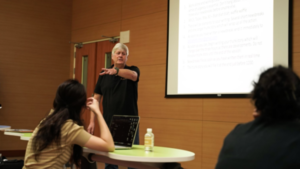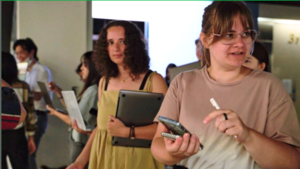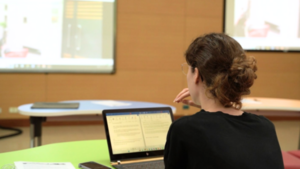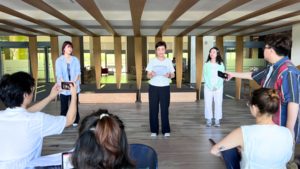Scenario Training Gives Communications Students Realistic Journalism Experience




Date :
2024-06-11
Department :
Master’s Program in Global Communication and Innovation Technology
【Article by Master’s Program in Global Communication and Innovation Technology】
Students enrolled in the International News Reporting course were given a unique opportunity to experience a simulated breaking news scenario. The course instructor, Phil Smith, a former career-long Reuters journalist and editor, led the event, aiming to provide students with a realistic glimpse into the fast-paced world of journalism.
Phil ran a carefully planned three-hour scenario that immersed students in a real-time situation. It included multiple press releases, televised news segments, and simulated press conferences. Volunteer actors from the Master’s Program in Global Communication and Innovation Technology (GCIT) office staff brought the scenario to life, engaging students in a flurry of activity.
Fourteen students from across the world and from diverse backgrounds took part. These were from the GCIT program and other international programs, such as the BA program of the International College of Innovation and the International Master's Program in Asia-Pacific Studies, were given briefing materials several days in advance. They were tasked with disseminating breaking news updates as they unfolded and were tasked with writing urgent newsbreaks in line with the evolving situation.
Reflecting on her experience, Karolina Kubicova, a student at GCIT from Czechia, initially felt nervous but ultimately found the scenario-based training exciting and engaging. The scenario revolved around a corruption scandal narrative and included disruptions such as hecklers at press conferences and even a simulated assassination attempt. Kubicova emphasized the value of the exercise, saying, "It was a helpful experience to get an understanding of what it's like to work as a reporter." As a conclusion, students were assigned to create a complete news story covering the morning's events.
In today's digital age, old news distribution models have changed, particularly for journalists on the ground. News scenario training has become essential to meet today’s demand for faster news. Because of the demands of the digital world and mobile technology, modern journalism has evolved to a point where all reporters have to deliver copies urgently themselves, as most cannot rely on the luxury of agency news feeds.
The old model, in which news agencies rushed to break news for their customer media subscribers to pick up, is not available for many of the smaller media groups that now exist.
The subscription model is still in play but is expensive. While the large media groups can afford to pay for Reuters, AP, AFP, or local agency breaking news feeds, the majority cannot.
For most journalists, the days of waiting for breaking news agency copy to arrive before they start writing are gone.
Scenario training is essential to instilling a sense of urgency in reporting styles if students are to be successful in gaining jobs in the industry. For all the above reasons, many media groups have time-limited writing tests as part of their interview process. This course is designed to prepare students for the change in dynamics the industry has undergone in the past decades.
The event, which took place on Friday, May 31, at the Research and Innovation Incubation Center of National Chengchi University, emphasized the significance of hands-on experiences in preparing the next generation of journalists.
Students enrolled in the International News Reporting course were given a unique opportunity to experience a simulated breaking news scenario. The course instructor, Phil Smith, a former career-long Reuters journalist and editor, led the event, aiming to provide students with a realistic glimpse into the fast-paced world of journalism.
Phil ran a carefully planned three-hour scenario that immersed students in a real-time situation. It included multiple press releases, televised news segments, and simulated press conferences. Volunteer actors from the Master’s Program in Global Communication and Innovation Technology (GCIT) office staff brought the scenario to life, engaging students in a flurry of activity.
Fourteen students from across the world and from diverse backgrounds took part. These were from the GCIT program and other international programs, such as the BA program of the International College of Innovation and the International Master's Program in Asia-Pacific Studies, were given briefing materials several days in advance. They were tasked with disseminating breaking news updates as they unfolded and were tasked with writing urgent newsbreaks in line with the evolving situation.
Reflecting on her experience, Karolina Kubicova, a student at GCIT from Czechia, initially felt nervous but ultimately found the scenario-based training exciting and engaging. The scenario revolved around a corruption scandal narrative and included disruptions such as hecklers at press conferences and even a simulated assassination attempt. Kubicova emphasized the value of the exercise, saying, "It was a helpful experience to get an understanding of what it's like to work as a reporter." As a conclusion, students were assigned to create a complete news story covering the morning's events.
In today's digital age, old news distribution models have changed, particularly for journalists on the ground. News scenario training has become essential to meet today’s demand for faster news. Because of the demands of the digital world and mobile technology, modern journalism has evolved to a point where all reporters have to deliver copies urgently themselves, as most cannot rely on the luxury of agency news feeds.
The old model, in which news agencies rushed to break news for their customer media subscribers to pick up, is not available for many of the smaller media groups that now exist.
The subscription model is still in play but is expensive. While the large media groups can afford to pay for Reuters, AP, AFP, or local agency breaking news feeds, the majority cannot.
For most journalists, the days of waiting for breaking news agency copy to arrive before they start writing are gone.
Scenario training is essential to instilling a sense of urgency in reporting styles if students are to be successful in gaining jobs in the industry. For all the above reasons, many media groups have time-limited writing tests as part of their interview process. This course is designed to prepare students for the change in dynamics the industry has undergone in the past decades.
The event, which took place on Friday, May 31, at the Research and Innovation Incubation Center of National Chengchi University, emphasized the significance of hands-on experiences in preparing the next generation of journalists.
